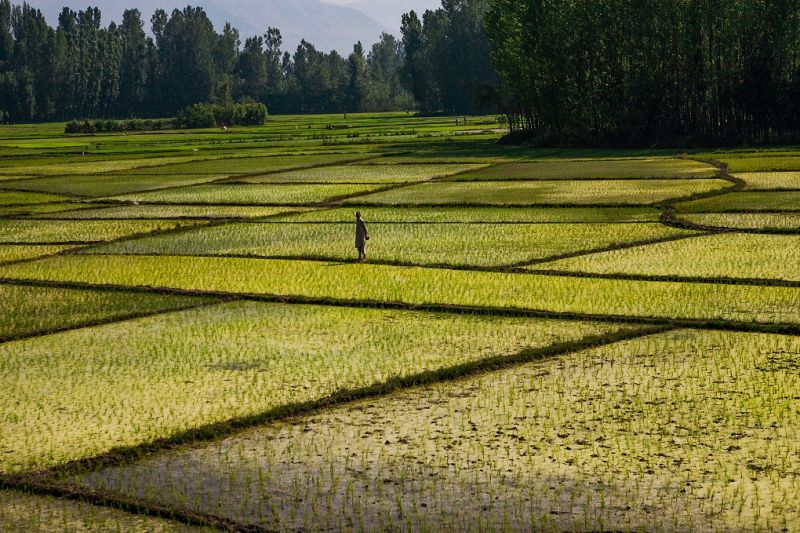Pakistan World’s Top Groundwater Exporter, India Ranks 3rd
Published on by Water Network Research, Official research team of The Water Network in Government
Highly water- and energy-scarce countries like India and Pakistan are losing huge amounts of groundwater and energy because of their food exports.

The use of standing water to grow rice in India and Pakistan leads to large-scale water loss.
Credit: sandeepachethan /Flickr
Pakistan is the world’s largest exporter of groundwater through its grains export. India is the third largest. Going by per capita availability, Pakistan is almost a water-starved country. The parts of India from which most grains are exported are seriously water-scarce.
In 2010, Pakistan exported grains that had cost 7.3 cubic km of groundwater to grow. India exported grains that cost it three cubic km to grow. India is also the world’s largest extractor of groundwater. In 2010, 75 cubic km of groundwater were extracted in India.
The trifecta of groundwater depletion for water-intensive crops, grain exports and the use of electricity for mining groundwater add up to a perfect recipe for disaster. Climate change impacts are worsening the situation.
The recent report that the new government in (Indian) Punjab has sought New Delhi’s permission to sell excess electricity to Islamabad has been welcomed in power-starved Pakistan. But this electricity will do much more than keep Pakistanis cool during the torrid summer. It will accelerate groundwater pumping in India. Not just precious groundwater, India and Pakistan are also effectively exporting energy when they export grains.
Surface water and soil moisture also play big roles in agriculture. Many countries save this water by importing grains. For those who do not, such thoughtless export of groundwater should be the biggest worry, because the timescales for recharging groundwater are significantly longer than those for surface water and soil moisture.
The sobering numbers on groundwater depletion and international food trade have been reported in the journal Nature by Carole Dalin and colleagues. About 11% of all groundwater depletion over the planet is involved in international food trade. Over two-thirds of that depletion is by Pakistan, the US and India.
Groundwater depletion in India
In India, wheat accounts for 35% of the total groundwater depletion and rice for about 25%, while fodder, cotton and sugarcane make up the rest. Average groundwater consumption to grow one kilogram of wheat is 812 litres, rice 200 litres (because it is far more dependent on surface water) and maize 72 litres, respectively. In the 2016-17 financial year, India is estimated to have exported 3,00,000 tonnes of wheat, 10.7 million tonnes of rice and 700,000 tonnes of maize.
When considering grain exports, it should be noted that the actual water exported is what is embedded in the grains themselves. This is much smaller than the total water used to grow crops, of which a small fraction of the water used in growing crops is recoverable – as it seeps back down to the water table. A much larger amount of water expended is simply lost to evaporation. This loss drives down groundwater tables, and is key to understanding how water intensive crops affect groundwater in a region. Thus the water footprint is critical to monitor as far as food exports are concerned, especially for countries like India and Pakistan that face persistent domestic and international water conflicts.
Even the embedded water approach employed by Goswami and Nishad points out that India exports a total water of around 25 cubic kilometres in food exports (not separated into surface and groundwater). The bad news is still that the near self-sufficiency in food production comes with a penchant to export some of it with hard-to-estimate externalities like groundwater depletion and salinisation as well as degradation of soil health and the environment.
Exports of meat, sorghum and fruits are significant additional factors. India is also among the largest beef exporters and beef is easily the most water – and grain-intensive food group per calorie. International food trade is a reality of a global economy and India has no choice but to partake in it. But the unintended consequences in the food-water-energy nexus can be ignored only at grave risk to national security.
Read more: The Wire
Media
Taxonomy
- Resource Management
- Groundwater
- Water-Energy Nexus
- Water Supply
- Water Export
- Consumption
- Hydrology
- Groundwater Mapping
- Groundwater Resource
- India
3 Comments
-
Besides virtual water concept actually grains contain 10 % moisture but animal product contain 80 % moisture. In the process as well as in the product we are loosing water. We all are having the responsibility to feed the Nation and then the World. So building up of infra-structure to harvest rain water and recharge groundwater with the profit amount may be a possible option.
1 Comment reply
-
French English
Bonjour
Je ne pense pas que la véritable problématique vienne de l'empreinte de l'eau sur toute sa consommation.
Pour moi elle vient plutôt de la gestion de l'eau une fois consommée. Elle est rejetée dans l'environnement telle qu'elle sans autre forme d'épuration de la pollution dissoute.
Tot ou tard cette pollution dissoute se retrouve dans l'eau potable des réserves souterraines et dans la production agronimique, notre base alimentaire.
Hello I don't think that the real problem comes from the water footprint on its consumption.
For me it comes rather once consumed water management. It is released into the environment as it without further purification of the dissolved pollution.
Sooner or later this dissolved pollution is found in drinking water in underground reserves and production agronimique, our food basis.
-
-
Bonjour ce qui est terrible c'est qu'aucun spécialiste n'a pu prévoir ceci et anticipé avant d'arriver à ce stade de dépendance et d'insuffisance
Hello what is terrible is that no specialist was able to foresee this and early before we get to this stage of addiction and failure
-
An excellent perspective! However, who is listening/reading? And can a body be not formed to regulate and guide cropping in such regions?